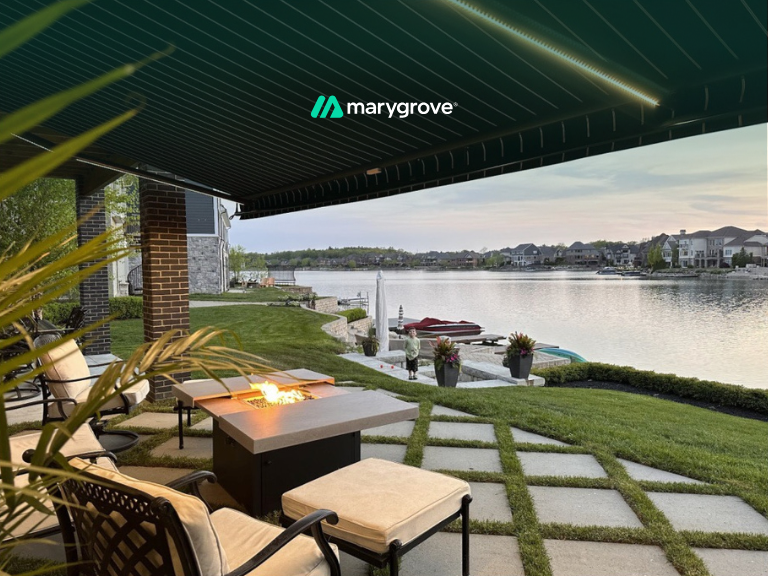A quality awning protects outdoor furniture from fading, cracking, heat buildup, and unexpected weather, keeping it comfortable, clean, and ready to use without daily setup or early wear.
How Awnings Keep Your Porch Furniture Protected and Ready to Use
Porch furniture is only as durable as the conditions it faces.
Even the best pieces fade, crack, or mildew when exposed to direct sunlight, rain, or daily temperature swings.
That’s where an awning makes all the difference.
By blocking harmful UV rays and creating a stable microclimate, an awning protects what matters most, your outdoor space. Here’s how it helps:
- Shields against fading, warping, and brittle materials
- Keeps cushions and surfaces cool and instantly usable
- Reduces exposure to bird droppings, tree sap, and rain
- Adds weather-smart features like auto-retract and wind sensors
- Supports clean, low-maintenance spaces ready for everyday use
It’s not just about shade. It’s about reducing stress, saving time, and getting more life out of every piece on your porch, deck, or poolside setup.
Combine it with a few simple upkeep habits and you’ve got a long-term strategy that works across seasons. And when the seasons change or storms roll in?
Knowing your awning’s limits is just as important.
Stick around and we’ll show you exactly how to make the most of your awning, plus other smart steps to help your porch furniture last longer, look better, and stay ready for everyday use.
What Happens to Porch Furniture Left Out in the Sun Too Long?
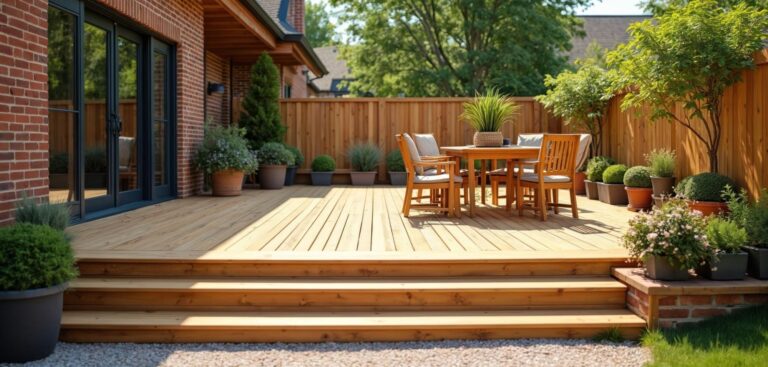
Outdoor furniture is built to handle the outdoors, but constant exposure to sun and heat takes a real toll.
Without shade, cushions, wood, and even metal frames start to degrade long before their time. Understanding how direct exposure harms your setup is the first step to protecting it.
Heat Isn’t Just Uncomfortable, It’s Damaging
Hot sun quickly breaks down materials. Cushion foam loses its bounce, wood cracks or warps, and plastic turns brittle.
Even glass tabletops can yellow or develop stress fractures from repeated temperature swings. These effects shorten the life of your furniture and happen faster than most homeowners expect.
Sunlight Dulls More Than Color
UV rays bleach fabrics and fade wicker or painted finishes.
This fading often happens unevenly, leaving furniture sets mismatched and dull. Painted or stained wood also needs more frequent refinishing just to stay presentable.
Once fading sets in, it is difficult to reverse without costly maintenance.
Furniture Gets Too Hot To Enjoy
On sunny afternoons, cushions become too hot to sit on and metal surfaces can burn to the touch. Instead of spontaneous outdoor meals or relaxation, you end up waiting until things cool down.
Over time, that lack of instant usability reduces the enjoyment of your outdoor space.
Daily Setup Becomes A Chore
To protect exposed furniture, homeowners often drag cushions inside or cover them each day.
Outdoor rugs and fabrics also collect dust and grime faster under direct sun, which means more cleaning and less relaxing.
This cycle of upkeep leaves many looking for a better long-term solution.
All of this sets the stage for the next section, how the right awning can stop this cycle and keep your porch furniture comfortable, clean, and ready to use.
Helpful Resource → How Awnings Reduce Heat: Smart Shade for Cooler Homes
How Awnings Help Protect and Prolong the Life of Your Porch Furniture
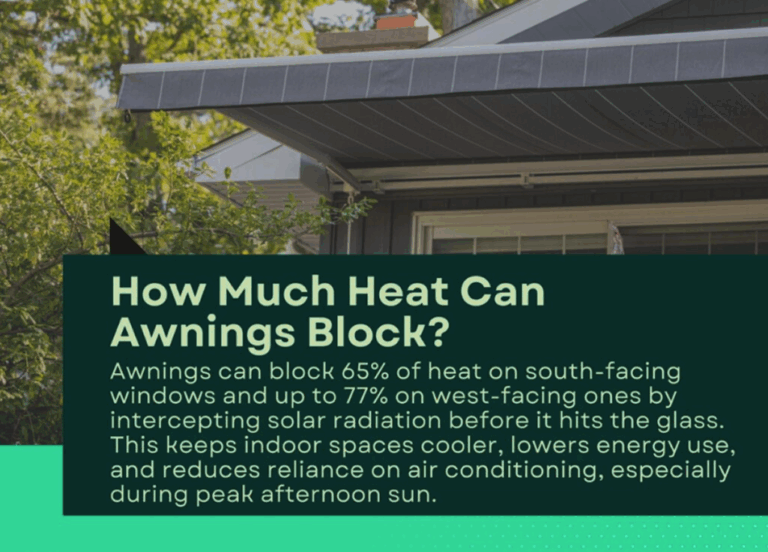
A quality awning isn’t just a shade, it’s protection.
Whether you’re outfitting a patio, covering a poolside setup, or keeping your outdoor workspace comfortable, the right awning adds serious staying power to your furniture.
It shields against heat, UV, and daily wear in ways that truly extend the life of your space.
Blocks UV to Prevent Fading and Cracking
Awnings reduce the amount of direct sunlight hitting your furniture by as much as 65 to 77 percent, depending on fabric and angle.
That level of UV protection helps slow fading, keeps painted finishes from cracking, and prevents wicker or wood from drying out and becoming brittle.
Regulates Temperature and Reduces Warping
By filtering heat before it hits your surfaces, awnings prevent the temperature extremes that break down adhesives or cause wood to expand and contract.
This is especially useful in areas where furniture sees all-day sun, like deck seating or west-facing porches.
Keeps Furniture Instantly Usable
Unshaded cushions and tabletops can get too hot to touch by midday.
With consistent shade, your outdoor space stays cooler and more inviting, whether you’re settling into a weekend lunch or jumping into an early morning call from your outdoor home office.
Shields From Rain, Bird Droppings, and Debris
Awnings form a first line of defense against pollen, sap, bird droppings, and light rain.
That means less mildew, fewer stains, and a cleaner environment, especially helpful in uncovered zones like poolside lounge chairs or open pergola areas.
Smart Features Add Active Protection
Today’s motorized awnings do more than open and close.
Built-in wind sensors and app control let your system retract automatically during harsh weather. It’s a hands-free way to protect your awning, and the furniture beneath it, before damage occurs.
Up next, we’ll look at simple habits that work hand in hand with awnings to help your porch furniture last even longer.
Helpful Resource → Keep Birds Out of Retractable Awnings: Complete Guide
What Else You Can Do — Smart Habits That Boost Furniture Protection
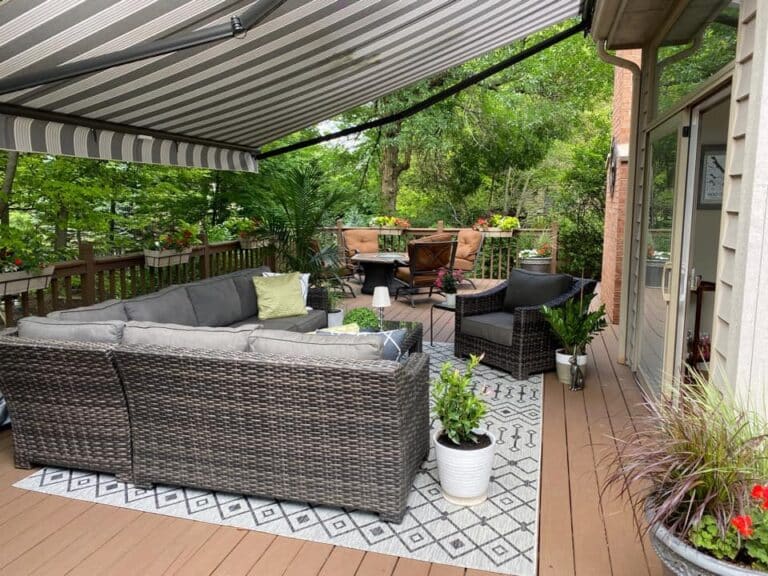
Awnings provide the foundation for long-term furniture protection, but they work best when paired with a few smart, low-effort habits.
These added steps help shield your setup year-round, especially during off-hours, changing seasons, or in spots where full shade coverage isn’t always possible.
Use Covers During Long Gaps or Bad Weather
Even with an awning in place, furniture covers are helpful during winter or long stretches of rain.
They act as a backup layer, especially when you’re away or not using the space for a while. Together with an awning, they give you more complete protection across seasons.
Choose Weather-Resistant Materials
Start with furniture that’s built to last. Look for powder-coated metals and UV-rated fabrics that resist fading and rust.
Avoid thin plastics or untreated wood, which wear down faster even under partial cover. The better the material, the more your awning can help it thrive.
Keep Furniture Clean and Maintained
Dust, mold, and insects find their way into even the most protected corners.
A regular wipe-down and seasonal inspection can prevent long-term damage. Catching wear early, like small tears or loose joints, makes it easier to fix before it spreads.
Move Furniture Based on Sun and Season
If parts of your porch get more sun during certain months, adjust your layout accordingly.
Rotating pieces or using side panels helps maximize the shade your awning provides. Small shifts in placement can make a big difference in how well your furniture holds up.
Paired with the right awning, these everyday habits go a long way toward making sure your porch stays inviting and your furniture stays strong.
And of course, even the best awnings have their limits.
Knowing when to retract them, and what they’re not meant to handle, can make all the difference in long-term performance.
Helpful Resource → Backyard Cooling Ideas: 9 Ways to Beat the Heat
When to Retract Your Awning, and What They’re Not Designed to Do
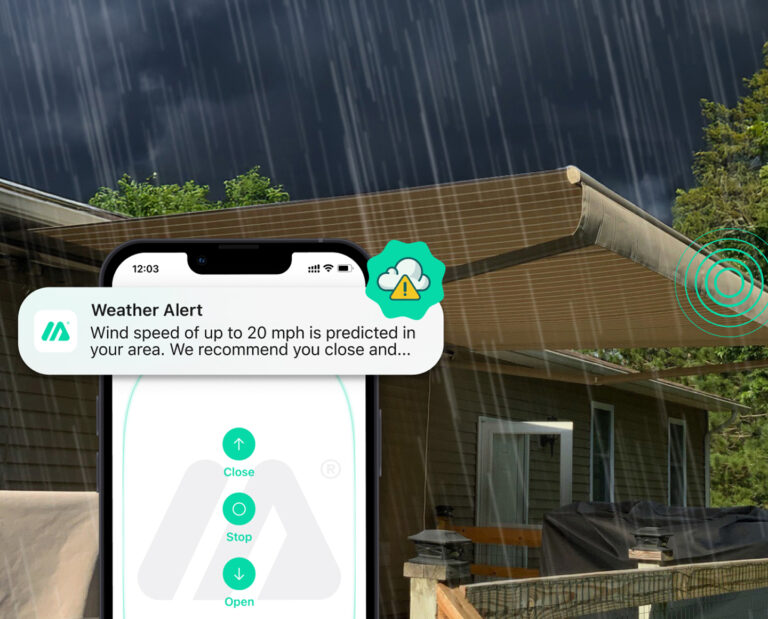
While awnings offer excellent everyday protection, they aren’t made to handle every weather event.
Knowing when to retract them, and what conditions they’re not built for, helps prevent unexpected damage to both the awning and the furniture underneath.
Wind, Snow, and Storms Require Caution
Retractable awnings should always be closed when strong winds are in the forecast.
Anything above 20 mph can put strain on the frame and fabric, increasing the risk of collapse.
Snow buildup is also a problem, weight from even a light snowfall can bend the arms or tear the canvas. Use wind sensors or retract the awning manually before severe weather sets in.
Water Resistance Isn’t Waterproof
Most awnings are designed to resist light rain, not withstand full downpours or sideways gusts.
During storms, water may still reach your furniture, especially from the sides.
Adding optional side panels or screens can help reduce exposure, but the core protection is best suited for mild to moderate conditions.
Limited Use During Winter Months
In colder climates, it’s best to store or fully wrap outdoor furniture for the off-season.
While awnings continue to offer some protection during mild winter days, they aren’t built to handle full-scale snowfall or prolonged ice buildup.
Treat your awning as a 3-season solution, ideal for spring, summer, and fall, and simply give it a break when snow is on the way.
These limitations aren’t flaws, they’re part of using your awning smartly, the way it was designed: as a flexible, reliable layer of protection when you need it most.
Make Your Porch Furniture Last Without the Guesswork

Protecting outdoor furniture doesn’t need to be complicated.
With the right awning in place, you reduce sun damage, block unwanted debris, and enjoy your space without constant upkeep.
Add a few smart habits, like using covers, rotating layouts, and choosing better materials, and you’ll extend the life of your entire setup.
Awnings are tools, not just features.
Use them right, and they’ll do more than cool the space, they’ll make it usable year-round.
If you’re ready to upgrade your outdoor setup, explore Marygrove’s awnings for smart design, expert installation, and the best long-term protection for your porch furniture.
